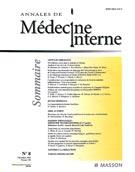Les besoins en calcium chez les hémodialysés parathyroïdectomisés - 16/02/08
Khalid ZAHIRI,
Khadija HACHIM,
El Mustapha FATIHI,
Mohamed Gharbi BENGHANEM,
Benyounès RAMDANI,
Driss ZAÏD
Voir les affiliationsLes besoins en calcium chez les hémodialysés parathyroïdectomisés |
La parathyroïdectomie change l'homéostasie du bilan calcique chez l'insuffisant rénal dialysé. Le but de ce travail est d'évaluer les besoins en calcium chez 20 hémodialysés parathyroïdectomisés, colligés dans le service de Néphrologie du CHU Ibn Rochd de Casablanca, de janvier 1994 à juin 1999. Ces patients sont répartis en 12 femmes (60 %) et 8 hommes (40 %) âgés de 14 à 70 ans (moyenne d'âge : 46,10 ± 13,62 ans). Le « hungry bone syndrome » a été noté chez 8 patients. L'hypocalcémie post-opératoire a été notée chez 15 patients (75 %) avec une calcémie minimale moyenne de 1,96 ± 0,21 mmol/l qui a été symptomatique chez 6 patients. La moyenne d'apport calcique la première semaine post-opératoire a été de 18,10 ± 0,54 g/j chez les 8 patients avec « hungry bone syndrome » et 14,28 ± 0,86 g/j chez les 12 patients restants. Entre 6 et 18 mois post-opératoires, le supplément calcique nécessaire était de 4,5 à 12 g/j chez les patients avec « hungry bone syndrome » contre 3 à 6 g/j chez les patients restants. La calcémie moyenne a été stable entre 2,16 mmol/l au 3 e mois et 2,48 mmol/l au 36 e mois. L'hypocalcémie post-opératoire reste un souci majeur après parathyroïdectomie, nécessitant une substitution massive en calcium et en dérivés actifs de la vitamine D, sous surveillance étroite pour mettre également ces patients à l'abri d'une hypercalcémie frénatrice de la fonction parathyroïdienne.
Calcium needs in hemodialyzed-parathyroidectomized patients |
Parathyroidectomy changes the homeostasis of calcium balance in patients under dialysis for kidney failure. The aim of this work is to value calcium needs in 20 hemodialysed patients who underwent parathyroidectomy, in the department of nephrology of UHC Ibn Rochd of Casablanca from January 1994 to June 1999. These patients, 12 women (60%) and 8 men (40%), aged between 14 and 70 years (mean = 46.10±13.62 years). Hungry bone syndrome was noted in 8 patients and postoperative hypocalcemia in 15 (75%). Mean minimal serum calcium was 196±0.21mmol/l, with clinical signs in 6 patients. Mean calcium supplement the first postoperative week was 18.1±0,54g/day in the 8 patients with hungry bone syndrome and 14.28±0,86g/day in the 12 remaining patients. Between 6 and 18 months postoperatively, required calcium supplementation was 4.5 to 12g/day in patients with hungry bone syndrome compared with 3 to 6g/day at the remaining patients. Mean serum calcium remained stable between 2.16mmol/l to the 3 rd month and 2.48mmol/l to the 36 th month. Postoperative hypocalcemia remains a major concern after parathyroidectomy requiring massive substitution with calcium and active vitamin D metabolite under close supervision to spare these patients from hypercalcemia resulting from parathyroid dysfunction.
Mots clés : Hypocalcémie , Hyperparathyroïdisme , Parathyroïdectomie , Calcium , Vitamine D
Keywords:
Hypocalcaemia
,
Hyperparathyroidism
,
Parathyroidectomy
,
Calcium
,
Vitamin D
Plan
© 2002 Elsevier Masson SAS. Tous droits réservés.
Vol 153 - N° 7
P. 433-439 - novembre 2002 Retour au numéroBienvenue sur EM-consulte, la référence des professionnels de santé.

